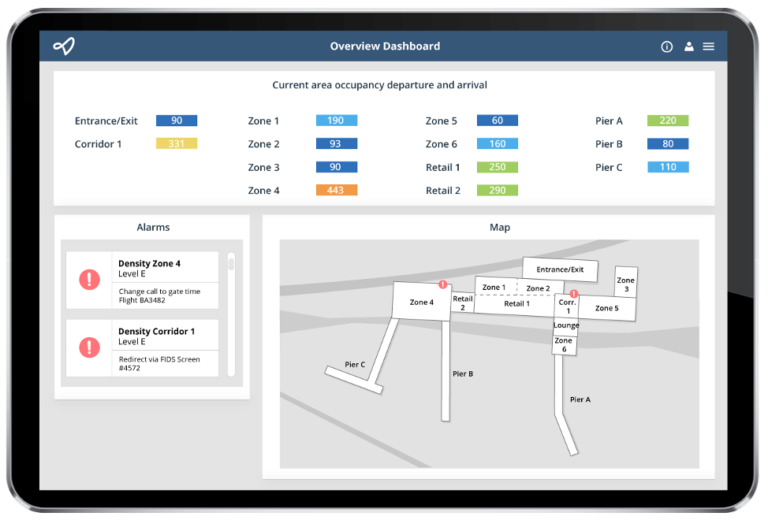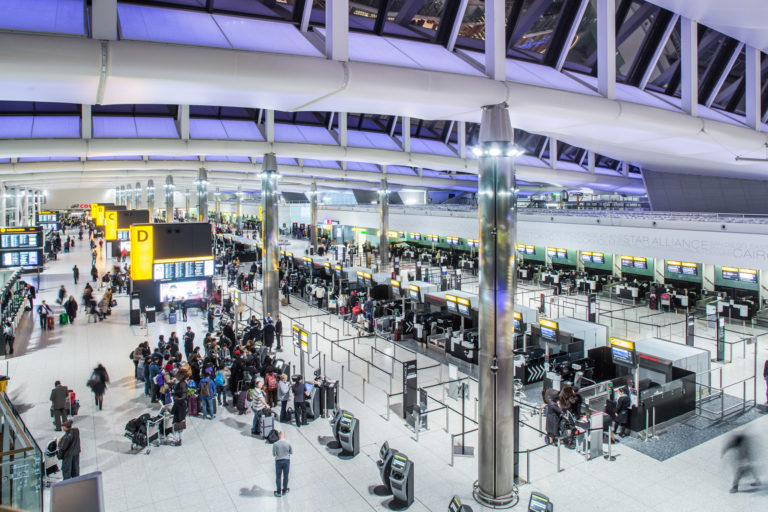by Dermot Davitt dermot@moodiedavittreport.com Source: ©The Moodie Davitt Report 7 May 2020

Siobhan Doyle (left), Marketing Manager at airport consultancy Veovo, considers how to deliver a smarter customer experience in the post-COVID-19 era.
Cast your mind back to February and a typical busy airport scene – the packed check-ins; passengers sitting shoulder-to-shoulder at gate lounges; jostling crowds at baggage carousels; hugs and handshakes at arrival halls.
So much has changed in such a short time. With the rapid spread of COVID-19, airport terminals have gone from bustling hubs of activity to eerily empty spaces.
But as the infection peaks seem to be passing, governments will be turning their thoughts to getting the economy kicking back into gear. The air transport industry’s ability to demonstrate that it can support reasonable social-distancing will be a critical factor in the pace at which lockdown rules will be relaxed.
Minding the gap
As economic activity slowly returns, airports are hoping that travellers take to the skies again, and quickly. But confidence will need to be earned. With social distancing being our primary weapon against COVID-19 for the foreseeable future, operators face new-found challenges in keeping people apart and preventing terminals from becoming potential virus breeding grounds.
Success will, in part, come down to the airport’s ability to predict and measure passenger movement and densities – when they arrive, where they dwell and how they choose to congregate – and using that knowledge to manage people flow and distribution.
Timely communication will be essential for building community trust. With their health and safety potentially on the line, passengers will want reassurance that airports are taking the right measures. How long are the checkpoint queues? When were surfaces last sanitised? Which are the least crowded areas in which to wait? And many will want the answers before putting a foot inside the terminal.
Machine learning technology and real-time monitoring may hold the answers to managing social distancing and minimising risks in the new normal.
Social distancing – terminal wide
Safe passenger separation management will rely on the ability of operators to not only understand passenger density across the terminal in real-time but to take pre-emptive action to prevent crowding. There are several ways airports can do this, combining the best mix of data capture technology, analytics, and decision metrics to support their layout, budget and operational priorities.
3D cameras are ideal for people counting and understanding occupancy in queues and smaller areas such as concessionaire stores and restaurants.
The need to measure passenger density in the terminal could be part of the future
For larger areas, blanket coverage with cameras is too expensive. The most cost-effective and accurate approach to understanding how people move and dwell is to adopt a hybrid of various sensor technologies, including cameras, people counters and wifi/BLE sensors.
Passenger Density analytics measures the degree of risk in real-time, derived from distancing measurements, crowd movement patterns and the size of the area being monitored. Alerts and automated action can be triggered if density thresholds are exceeded.
With this insight, airports can then make intelligent, proactive decisions to limit the number of people congregating such as redirecting flow with digital messages, adjusting call to gate times or spreading gate and baggage belt allocations.
Safer, smaller queues
When people take to the air again, queues at departure checkpoints will be inevitable. What is less known is how airports will enforce social distancing, without creating endless, snaking lines.
One way is to cap entry to checkpoint areas – the fewer people in, the smaller the queue. This can be achieved by linking occupancy measures with airport screens, to advise passengers when lines are of a safe size to enter the area, and which queue they should join.
Once in the queue, camera sensors can measure the average distance between passengers and generate alarms if passenger density thresholds are exceeded, or automatically redirect and redistribute passengers to different lines and checkpoints.
Queue management is likely to occupy the minds of airport managers in this new world of travel
Passenger power
Another way to streamline arrivals and minimise congestion is by adopting virtual queues.
Using this technology, passengers can pre-book a time slot for processing, such as for check-in or security. This helps prevent passengers from feeling locked in any area, for any length of time – giving them control over their airport journey.
Time slots can be adjusted in real-time, based on queue wait times, changing arrival patterns, lane productivity and processing capacity. While waiting, passengers have the choice to shop, grab a drink or wait in less-crowded areas.
Not only do virtual queue bookings give passengers greater peace of mind, but they can also provide airports with better forecast data, for more accurate checkpoint planning.
In future, travellers may be able to pre-book a time slot for check-in or security (Heathrow Airport pictured)
A different operational context
It’s not just the passenger crowding and flows, which will need a different approach. The way airports allocate gates, baggage carousels and manage turnarounds, will need a radically new perspective. They will need to be more mindful about how they distribute gate allocations to maximise separation, while accommodating the flight volume.
Incoming baggage may need to be separated, across multiple belts, or at the very least, separated from other flights, arriving at the same time. Plane turnarounds will increase to allow for extended cleaning. These are all piling on operational and economic challenges in an environment, which is already stretched prior to Covid-19.
One possible solution is to create close integration between the airport’s passenger forecasting and density management systems, and resource management system. This will allow real-time awareness of the situation in the terminal, and to allow the operations team to make smarter decisions, to balance operational efficiencies within the airport.
Keflavik Airport, Iceland: Dynamic forecasting has improved operational efficiency, says airport company Isavia
Moving right along
Before the pandemic, airports typically relied on experience and historical data to get a sense of when passengers were likely to show up. But with so many new variables to contend with – changing flight schedules, social distancing, additional health screenings, more regular cleaning – arrival and processing guesstimates, based on last year’s or even last month’s data, are no longer relevant.
The only way for airports to make truly safe and accurate planning decisions will be by basing them on real, up-to-the-minute information.
Dynamic forecasting software may have the answer. It allows airports to take live schedule data to create accurate passenger show-up forecasts for each processing point. The forecast and capacity plan is then continually updated to account for live situations, such as a predicted occupancy breach. Accurate forecasts also enable airports to plan how to channel passengers around the concourse to reduce crowd density.
Keflavik Airport recently reaped the benefits of live forecasting, as it was grappling with a continually changing flight schedule.
“Dynamic forecasting, linked to the live flight schedule and updated with passenger data, as it became available, gave us an early heads up to expected passenger arrivals. This allowed us to adjust our plans and rosters to reflect the current situation, improving journeys and lowering costs,” said Hanna María Hermannsdóttir, a specialist in operation research at Isavia.
Embracing the new order
One thing we can be assured of – the aftermath of COVID-19 will see changes to terminal operations on a scale far more significant and long-lasting than after 9/11.
On the upside, there’s no need to wait for new technology to be invented to help people maintain healthy distances in terminals. It is already here. With bundled on-demand services, predictive intelligence, and occupancy monitoring systems, airports can be supporting social distancing within weeks of installation.
By connecting airport staff to answers and actions, you not only help get passengers back in the air sooner – you can, at the same time, build a smarter customer experience platform for the future.
source : https://www.moodiedavittreport.com/comment-airport-terminals-in-a-post-covid-19-world/

